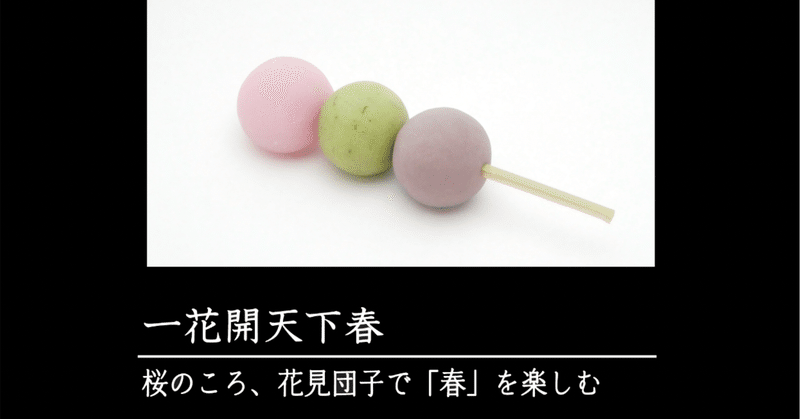
花見の季節の和菓子 - 花見団子(西陣・塩芳軒)
3月にいただく茶菓子の代表格、花見団子。
この三色はピンク=花、緑=木や葉、黒=大地を表すと言われています。またお味もそれぞれで、緑はよもぎの香りがとても印象的です。
私は裏千家茶道のお稽古をしているのですが、このお団子の紅と緑の間に、隙間が作られてて供されることがよくあります。これは、花見団子は田楽箱に盛り付けられることが多いのですが、お家元の重箱には餡が直接木肌につかないようにと桟が渡してあり、それを避けるために隙間があるそうです。お茶の先生がお菓子屋さんに発注する際には、この隙間を開けるようにオーダーされることも多いようです。先日茶席でこのお茶菓子を頂いとき、亭主の方が「隙間を開けるように依頼した所、お菓子やさんは予想以上に大きくあけて仕上げてきたため、こんなに隙間が開いてしましまいました」と、面白いエピソードを語っていました。もしかすると茶人あるある、なのかもしれません。
先日武者小路千家のお家元の書籍をパラパラとみていると、この花見団子が出てきました。そこでもこの隙間についての記載があり、このような解釈がされていました。紅=天、緑=地、黒=人を表すため、天の団子をだけを少し離しておくようにしている。また団子をいただく際、隙間が、はずす手がかりにもなるとされ、細やかな気遣いや配慮の心から生まれた隙間でもあると。もう一つ興味深かったのが、青竹を串に使うことで庶民的な花見団子を、ハレの日のお菓子へとグレードアップさせているということです。青竹は特別な存在で、茶の正月と言われる口切り(11月に行われる)では青竹の蓋置や花入れなどが登場します。それらが時間を経て薄い飴色へと変わっていくさまに、自らの思いや成長を投影したりしなかったり……。
それで思い出したのが、花見団子を食べるとき、お茶席では一つづつ団子を串から離して懐紙にとっていただくということ。今ではきちんと団子を串から外していただけるように成長しましたよ。お茶席で花見団子登場したとき、くれぐれも串にかぶりつかないように(笑)!
画像引用:塩芳軒
Hanami Dango is typical of the tea sweets we enjoy in March. The three colours are said to represent pink as the blossoming of flowers, green as trees and leaves, and black as the earth. Each with its unique flavor, but it's the green one that wins with its impressive aroma of mugwort for me.
As someone who practices the Urasenke tea ceremony, I have learned there is a gap between the red and green dango. This is because Hanami Dango is often served in a Dengaku box, and in the Iemoto's(the founder family of Urasenke) box, there is a partition board to prevent the dangos from touching the wooden surface directly, and the gap is there to avoid the board. When tea ceremony teachers order sweets from confectioners, they often ask for this gap to be opened.
The other day, when having these sweets at a tea ceremony, the master of the tea ceremony told an amusing story: "I asked the confectioner to open the gap, but the confectioner made a gap much bigger than I expected, so there was such a gap between the dangos which you are having." Perhaps this is a common occurrence among tea masters.
The other day, while flipping through a book by the head of the Mushanokoji Senke family, I stumbled upon the hanami dango. The book included a description of the gap between the dangos, which symbolizes red as heaven, green as earth, and black as people, with only the heavenly dango kept slightly apart from others on the earth. Interestingly, the gap also serves as a clue to remove the dangos from the skewer which reflects a mind of carefulness and consideration.
Additionally, the use of green bamboo as a skewer elevates the ordinary Hanami dango to the celebrated confectionery. Green bamboo has a special significance, and it makes an appearance as Futaoki or flower base during Kuchikiri (held in November), which is known as the New Year of Tea. The green bamboo change color over time to a light candy shade, which may or may not represent my growth !?!? haha, but at least it gives us a sense of time.
This brought to mind the proper way to eat Hanami Dangos during a tea ceremony, which involves removing each dumpling from the skewer and placing it on a piece of kaishi paper. I've learned to do this correctly, so I advise you guys, don't bite into dangos with the skewer at a tea ceremony! lol
この記事が気に入ったらサポートをしてみませんか?
